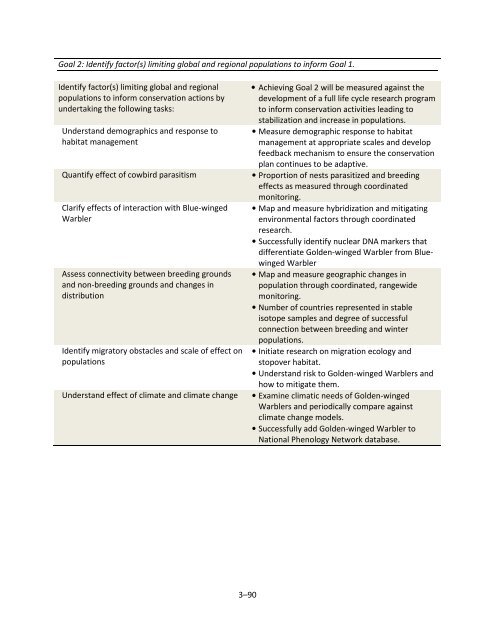Review and download Chapter 3 - Golden-winged Warbler Working ...
Review and download Chapter 3 - Golden-winged Warbler Working ...
Review and download Chapter 3 - Golden-winged Warbler Working ...
Create successful ePaper yourself
Turn your PDF publications into a flip-book with our unique Google optimized e-Paper software.
Goal 2: Identify factor(s) limiting global <strong>and</strong> regional populations to inform Goal 1.<br />
Identify factor(s) limiting global <strong>and</strong> regional<br />
populations to inform conservation actions by<br />
undertaking the following tasks:<br />
Underst<strong>and</strong> demographics <strong>and</strong> response to<br />
habitat management<br />
3–90<br />
• Achieving Goal 2 will be measured against the<br />
development of a full life cycle research program<br />
to inform conservation activities leading to<br />
stabilization <strong>and</strong> increase in populations.<br />
• Measure demographic response to habitat<br />
management at appropriate scales <strong>and</strong> develop<br />
feedback mechanism to ensure the conservation<br />
plan continues to be adaptive.<br />
Quantify effect of cowbird parasitism • Proportion of nests parasitized <strong>and</strong> breeding<br />
effects as measured through coordinated<br />
Clarify effects of interaction with Blue-<strong>winged</strong><br />
<strong>Warbler</strong><br />
Assess connectivity between breeding grounds<br />
<strong>and</strong> non-breeding grounds <strong>and</strong> changes in<br />
distribution<br />
Identify migratory obstacles <strong>and</strong> scale of effect on<br />
populations<br />
monitoring.<br />
• Map <strong>and</strong> measure hybridization <strong>and</strong> mitigating<br />
environmental factors through coordinated<br />
research.<br />
• Successfully identify nuclear DNA markers that<br />
differentiate <strong>Golden</strong>-<strong>winged</strong> <strong>Warbler</strong> from Blue<strong>winged</strong><br />
<strong>Warbler</strong><br />
• Map <strong>and</strong> measure geographic changes in<br />
population through coordinated, rangewide<br />
monitoring.<br />
• Number of countries represented in stable<br />
isotope samples <strong>and</strong> degree of successful<br />
connection between breeding <strong>and</strong> winter<br />
populations.<br />
• Initiate research on migration ecology <strong>and</strong><br />
stopover habitat.<br />
• Underst<strong>and</strong> risk to <strong>Golden</strong>-<strong>winged</strong> <strong>Warbler</strong>s <strong>and</strong><br />
how to mitigate them.<br />
Underst<strong>and</strong> effect of climate <strong>and</strong> climate change • Examine climatic needs of <strong>Golden</strong>-<strong>winged</strong><br />
<strong>Warbler</strong>s <strong>and</strong> periodically compare against<br />
climate change models.<br />
• Successfully add <strong>Golden</strong>-<strong>winged</strong> <strong>Warbler</strong> to<br />
National Phenology Network database.


